New York the main character in Kim Stanley Robinson’s new novel
The Big Apple of Kim Stanley Robinson’s new science fiction novel, New York 2140, is both recognisable and strange.

The Big Apple of Kim Stanley Robinson’s new science fiction novel, New York 2140, is both recognisable and strange. Climate change-driven sea level rise has flooded much of Manhattan, transforming its streets into a 22nd-century Venice, its grid of canals home to a riot of watercraft and crisscrossed by skybridges.
The unfamiliarity of this picture disguises how much remains the same. The social geography of Robinson’s New York is depressingly familiar. Uptown, glittering towers of glass and steel rise a kilometre into the air, climate-controlled eyries for the super-rich capitalist class. Downtown, the poor and displaced crowd into the crumbling maze of the Intertidal.
Elements of this will be familiar to readers of recent science fiction, including Robinson’s 2312, Aurora and the Mars trilogy. But New York 2140 is no cookie-cutter dystopia. On the contrary, it is a novel distinguished by its ambition.
In a cultural moment when retreating from the big picture is seen as a badge of honour, New York 2140 deliberately harks back to the panoptic social vistas of the 19th-century novel, seeking to explore not just the experiences of characters from all levels of society but to dramatise the social and economic relations in which they are enmeshed. To this end Robinson presents a sprawling cast of characters: two plucky street kids, a police detective, a building manager, an impassioned lawyer who works with refugees and the disenfranchised, a pair of coders with revolutionary intent, a callow but basically good-hearted commodities trader and an airship-flying, endangered species-rescuing internet (or cloud) star with a tendency to get naked … to name just a few.
This initially (but ultimately fortuitously) mismatched assortment of individuals is thrown together by an accident of geography: all call the retrofitted Met Life Tower on Madison Square home. Yet even despite that it takes the kidnapping of the coders — and a triple helping of coincidence — to bring them into contact with each other.
Yet while the aspirations and dilemmas of Robinson’s cast are diverting enough, ultimately they’re not the point of this novel. Instead, as its plot unfurls in its often delightfully digressive manner, chasing off after a lost British naval ship supposed to have been loaded with buried treasure and a mysterious box that may contain Herman Melville’s lost masterpiece, Isles of the Cross, it becomes clear the real star is the city itself.
Perhaps appropriately for a novel in which the central character is a place rather than a person, New York 2140 strives to embody some of the teeming variousness and layered history of the city in its fabric, shifting between voices and quoting liberally from an astonishing range of sources. The result is polyphonic, even exultant at times, echoing not just the work of modernists such as John Dos Passos but also John Brunner’s classic novel of overpopulation, Stand on Zanzibar.
Yet decentring the human actors also allows Robinson space to explore the multifaceted questions with which the novel is engaged, from the practicalities of floodproofing and speculative technologies designed to allow buildings to shift and move with the water, to the intricacies of the financial and commodities markets and in particular how risk and uncertainty are priced and traded.
These — and the history lessons provided by the narrator identified only as “The Citizen” — provide the drumbeat of darkness that gives New York 2140 its power. For in them Robinson offers a frighteningly plausible picture of what lies just over our horizon, imagining two instances of rapid, climate change-driven sea level rise that inundate coastal cities worldwide.
There is nothing new in this, of course. But by historicising the future Robinson makes this now almost certain yet somehow unimaginable scenario brutally real.
Yet this is not this novel’s only achievement. For alongside this portrait of the effects of rising seas, Robinson explores how markets might respond, arguing that despite the cost, capitalism will not falter but actually thrive, generating vast profits from rebuilding and relocation while tightening its grip on those under its yoke.
The final section of this huge, dizzying, often thrilling and deliberately optimistic novel concerns a scenario in which the characters engineer the overthrow of precisely this economic order, ushering in a new kind of future.
And while these sections strike me as utopian in the less generous sense of the word, they nonetheless underline a point that needs to be made often and loudly if we are to escape the disaster we seem hellbent on bringing down on ourselves, which is that “history does not stop happening. Seemingly frozen moments are transient, they break up like the spring ice, and then change occurs.”
James Bradley’s new novel is The Silent Invasion, the first volume of a trilogy for young adults.
New York 2140
By Kim Stanley Robinson
Hachette, 615pp, $29.99


